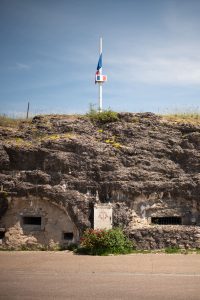
The construction of Fort Vaux took place from 1881 to 1884. It served as an observatory to monitor the plateau of the Vaux Ravine and the Woëvre Plain.
Initially, the fort was part of the first sector of the stronghold of Verdun. Its garrison consisted of a half-company of infantry, two sections of machine guns, 52 fortress auxiliaries, and 279 men.
On April 2, 1916, the Germans took control of the village of Vaux-devant-Damloup, but the fort resisted. From June 2 to 7, 1916, the French soldiers faced the German 50th Division. But the troops, exhausted, had to surrender. However, the Germans failed at Verdun and abandoned the fort in the fall. On the night of November 2 to 3, 1916, the French troops liberated the fort without a fight.
You can still visit the command post, infirmary, telecommunication post, dovecote, and Bourges casemate. A visit to Fort Vaux allows us to better understand the challenging living conditions of the soldiers during the siege. Bombarded between March 9 and June 7, 1916, by nearly 8,000 shells per day, it retains a particularly bumpy appearance today and bears witness to the violence of the bombardments.